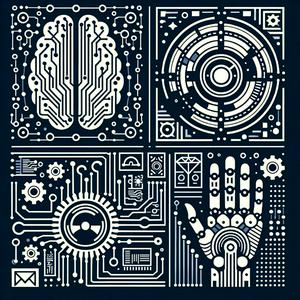Emerging Technology Trends: AI, Robotics & Digital Innovation

188 episodes

AI & Robots: From Lab Rats to Top Dogs - Whos Leading the Pack in 2026?
24/12/2025 | 5 mins.
This is you Emerging Technology Trends: AI, Robotics & Digital Innovation podcast.Artificial intelligence, robotics and digital innovation are shifting from experimental to operational, and the next year will be defined less by novelty and more by scale, integration and regulation. According to McKinsey’s 2025 technology trends outlook, over two trillion dollars in enterprise value is now tied to artificial intelligence, cloud and industrial internet of things platforms, with autonomous systems moving from pilots to production across logistics, manufacturing and services. At the same time, Deloitte’s Tech Trends 2026 notes that Amazon has passed one million warehouse robots, coordinated by its DeepFleet artificial intelligence to boost travel efficiency by around ten percent, a sign that intelligent machines are quietly becoming core infrastructure rather than side projects.In robotics, the International Federation of Robotics reports that industrial robot installations have more than doubled over the past decade, while service robots for logistics and healthcare are growing at over twenty percent annually. This year, Time highlighted Figure AI’s Figure 03 humanoid robot as one of the best inventions, underscoring how general purpose humanoids are leaving the lab and entering real warehouse and factory pilots. Innovation analyses such as The Innovation Mode’s 2026 technology outlook point to rapidly falling hardware costs, predicting that humanoids will scale in industrial settings by the late twenty twenties, opening new markets for small and mid sized businesses.Artificial intelligence breakthroughs are also reshaping software and science. Launch Consulting’s August 2025 briefing describes three important developments: a new frontier model enabling more capable automation, a universal deepfake detector reaching about ninety eight percent accuracy, and scientists using artificial intelligence to discover promising battery materials in weeks instead of years. Harvard Business School’s work on artificial intelligence trends for 2026 emphasizes that organizations now need “change fitness” more than static five year plans, sequencing predictive artificial intelligence for efficiency and then generative and agentic systems for new growth.Across industries, listeners can expect tighter fusion of artificial intelligence with internet of things, quantum and blockchain. Quantum computing remains early, but major cloud providers are already offering quantum simulators and small scale hardware for optimization, finance and materials research, while blockchain is quietly maturing in supply chain traceability and tokenized assets rather than speculative coins. At the edge, internet of things devices combined with on device artificial intelligence are driving real time monitoring in energy, smart cities and precision agriculture, while distributed artificial intelligence infrastructure is reducing cost by shifting workloads to the most efficient hardware.This acceleration raises serious integration and ethical challenges. Governments and regulators are moving toward risk based artificial intelligence rules, algorithmic transparency, and liability frameworks for autonomous robots in public spaces, while enterprises are building governance boards, model registries and audit trails. According to Deloitte and Harvard, the leaders will be those that align artificial intelligence with clear strategy, retrain their workforce and treat responsible use as a design constraint, not an afterthought.For listeners, three practical actions stand out. First, pick one high value workflow in your domain and prototype an artificial intelligence or robotics enhancement within ninety days, focusing on measurable outcomes such as cycle time or error reduction. Second, build or join a small cross functional group that tracks key developments in artificial intelligence, robotics, quantum and internet of things, translating news into concrete implications for your operations and skills. Third, invest in learning: basic data literacy, prompt and workflow design, and an understanding of your sector’s emerging regulations will be as critical as traditional software skills.Over the next few years, artificial intelligence agents will act as digital coworkers, humanoid robots will become more common in factories and logistics, quantum computing will begin to influence high value optimization and discovery problems, and connected devices will function as a planetary scale nervous system. Those who experiment early, govern thoughtfully and upskill continuously will be best positioned to turn disruption into durable advantage.Thank you for tuning in, and come back next week for more. This has been a Quiet Please production, and to learn more about me, check out Quiet Please Dot A I.For more http://www.quietplease.aiGet the best deals https://amzn.to/3ODvOtaThis content was created in partnership and with the help of Artificial Intelligence AI

Robots Rule! AI's Breakneck Surge Sparks Buzz, But Job Jitters Loom
23/12/2025 | 3 mins.
This is you Emerging Technology Trends: AI, Robotics & Digital Innovation podcast.As we step into late 2025, emerging technologies in artificial intelligence, robotics, quantum computing, blockchain, and Internet of Things are reshaping industries at breakneck speed. Agentic artificial intelligence, which enables systems to reason, plan, and execute complex tasks autonomously, stands out as a breakthrough, transitioning AI from thought partner to digital worker and compressing innovation cycles from months to days, according to The Innovation Mode blog. Humanoid robots from Tesla's Optimus, Figure AI, and Agility Robotics are scaling production, with manufacturing costs dropping 40 percent from 2023 to 2024, paving the way for factory and home use by the late 2020s.Cross-industry trends show physical AI surging, with robotics supported by edge processing accelerating in healthcare, retail, and logistics. MarketsandMarkets reports the global AI robots market growing from 6.11 billion dollars in 2025 to 33.39 billion by 2030 at a 40.4 percent compound annual growth rate, driven by machine learning and service robots. ABI Research notes the overall robotics market hitting 50 billion dollars this year, reaching 111 billion by 2030. Recent news underscores this: Amazon deployed its millionth robot coordinated by DeepFleet AI, per Deloitte Insights, while over 2.26 billion dollars flowed into robotics startups in the first quarter alone, says Marion Street Capital. Quantum computing shifts from prototypes to utility, solving problems in minutes that take supercomputers years, while blockchain and Internet of Things enhance secure, connected ecosystems in smart factories.Investments pour in, especially in North America and Asia Pacific, with Precedence Research projecting AI-driven industrial robotics at 8.98 billion dollars in 2025, ballooning to 49.11 billion by 2034. Yet regulatory and ethical hurdles loom, including data privacy and job displacement, demanding balanced trade-offs as Harvard Business School advises organizing AI around strategy. Integration challenges like human-robot collaboration are met by cobots, expected to claim 35 percent of sales by 2027 per StartUs Insights.Looking ahead, these technologies converge to disrupt manufacturing, healthcare, and beyond, creating new markets but requiring change fitness. Listeners, validate opportunities rapidly through AI-powered experimentation, build cross-disciplinary teams, and partner strategically to capitalize.Thank you for tuning in. Come back next week for more. This has been a Quiet Please production, and for me, check out Quiet Please Dot A I.For more http://www.quietplease.aiGet the best deals https://amzn.to/3ODvOtaThis content was created in partnership and with the help of Artificial Intelligence AI

Robots Steal the Show: AI's Seductive Dance with Industry at CES 2025!
13/12/2025 | 2 mins.
This is you Emerging Technology Trends: AI, Robotics & Digital Innovation podcast.As we step into the future on this crisp December morning, emerging technologies in artificial intelligence, robotics, and digital innovation are accelerating at an unprecedented pace, reshaping industries from healthcare to manufacturing. At CES 2025, showcased innovations like empathetic robotics and AI-powered wearables highlighted seamless smart home integration and personalized assistance, according to Fullstack Labs reports. Hyper-intelligent robots, blending enhanced AI for natural language processing and creative problem-solving, promise breakthroughs in surgical precision and disaster response, as detailed by FirstIgnite.Cross-industry trends reveal AI merging with robotics for autonomous mobile systems in warehouses, where Amazon's latest AI-trained robots now handle millions of diverse products through vast datasets, boosting efficiency without rigid programming, per Hürriyet Daily News on October 24, 2025. Tesla's Optimus updates on October 26, 2025, advanced dexterity for factory deployment, signaling a shift toward embodied AI beyond vehicles, reports opentools.ai. The International Federation of Robotics identifies top 2025 trends: physical AI for real-world simulation training, generative AI for robotics, and energy-efficient humanoids entering new business fields.Investment patterns show promise, with AI-robotics markets eyeing 190 billion dollars by year-end, per StartUs Insights, and collaborative robots projected to claim 35 percent of sales by 2027. Quantum computing and blockchain enhance secure IoT networks, while Bain notes quantum's rising potential alongside humanoid booms. Regulatory hurdles demand ethical AI governance for transparency and safety, as Accenture emphasizes human-AI partnerships. Integration challenges like latency in edge-cloud robotics find solutions in vision-language-action models from Google DeepMind.Predictions point to profound impacts: cobots transforming logistics, exoskeletons aiding mobility, and swarm systems revolutionizing exploration, per McKinsey's outlook. Market data from Deloitte underscores Amazon's millionth robot milestone, coordinating via DeepFleet AI.Listeners, practical takeaways include upskilling in AI-robotics via platforms like ROBOTIS for embodied AI, exploring robotics-as-a-service for small businesses, and prioritizing ethical audits in deployments. These trends herald harmonious human-tech collaboration, driving growth and quality of life.Thank you for tuning in. Come back next week for more. This has been a Quiet Please production, and for me, check out Quiet Please Dot A I.For more http://www.quietplease.aiGet the best deals https://amzn.to/3ODvOtaThis content was created in partnership and with the help of Artificial Intelligence AI

Robots Unleashed: AI's Transformative Touch Sparks Industry Disruption and Ethical Dilemmas in 2025!
03/12/2025 | 3 mins.
This is you Emerging Technology Trends: AI, Robotics & Digital Innovation podcast.Artificial intelligence and robotics are converging to create unprecedented opportunities across industries in 2025, fundamentally reshaping how businesses operate and compete. The integration of advanced AI with robotic systems has evolved beyond simple automation to create intelligent machines capable of learning, adapting, and reasoning in real-time. Foundation models and large language models are transforming robots from single-purpose, linearly-programmed machines into versatile systems that understand complex instructions, spatial awareness, and physical environments.The manufacturing sector is experiencing the most dramatic transformation. Smart factories now operate autonomously with AI optimizing production lines, inventory management, and energy consumption simultaneously. Predictive maintenance systems using machine learning analyze equipment data to identify failures before they occur, dramatically reducing costly downtime. According to industry analysis, one point three billion AI-powered robots are expected to be available by twenty thirty-five, fundamentally reshaping work across warehouses, factories, and logistics networks.Collaborative robots, known as cobots, have become commonplace in manufacturing, healthcare, and agriculture. These machines combine force-limiting sensors with advanced vision systems, allowing them to work safely alongside human employees. Recent developments in vision-language-action capabilities mean robots can now interpret scenes both visually and linguistically, then act with greater autonomy. This advancement enables robots to generalize tasks across environments they were not explicitly trained on.A significant market shift is robotics as a service, or RaaS. Rather than requiring enormous capital investments, companies are offering robots on subscription models, making robotic automation accessible to small and medium-sized enterprises. Combined with edge and cloud computing strategies, this approach allows local decision-making for speed and safety while high-level coordination happens remotely.Ethical considerations are becoming non-negotiable. As robots gain more autonomy, ensuring predictable, transparent, and safe behavior aligned with human values is emerging as essential. Meanwhile, AI-powered defect detection in semiconductor manufacturing has achieved ninety-seven point six percent accuracy, demonstrating how these technologies directly impact product quality and yield.For organizations, the practical takeaway is clear: investment in AI-robotics integration is no longer optional but essential for competitive advantage. Businesses should prioritize workforce training, establish clear governance frameworks, and develop comprehensive safety protocols as these technologies expand operational capacity.Thank you for tuning in. Come back next week for more emerging technology insights. This has been a Quiet Please production. For more, check out Quiet Please dot A I.For more http://www.quietplease.aiGet the best deals https://amzn.to/3ODvOtaThis content was created in partnership and with the help of Artificial Intelligence AI

AI & Robots Steal 20 Million Jobs: Is Your Career Safe?
01/12/2025 | 3 mins.
This is you Emerging Technology Trends: AI, Robotics & Digital Innovation podcast.# Emerging Technology Trends: AI, Robotics & Digital InnovationWelcome to Quiet Please. Today we're exploring the transformative technologies reshaping our world in 2025.Artificial intelligence has moved beyond laboratories into everyday applications. The global AI and robotics market opportunity has reached 190 billion dollars, with generative AI fundamentally changing how businesses operate. Recent breakthroughs like deepfake detection technology achieving 98 percent accuracy demonstrate AI's evolving sophistication in addressing critical challenges. Tesla's October updates to its Optimus humanoid robot showcased unprecedented advances in dexterity and perception, signaling a major shift toward embodied artificial intelligence systems capable of real-world manufacturing and logistics tasks.Collaborative robots represent a particularly compelling trend. These cobots are projected to account for nearly 35 percent of all robot sales by 2027. Unlike traditional industrial robots, they work safely alongside humans, making automation accessible to small and medium enterprises. Their simplified programming and intuitive interfaces democratize robotics technology across industries.Amazon's deployment of artificial intelligence trained warehouse robots illustrates practical implementation at scale. These systems learn from vast datasets to identify, sort, and handle diverse products without individual programming for each task. This represents a fundamental shift from rigid procedural automation toward intelligent, adaptive systems.Digital twin technology creates virtual replicas of physical systems, enabling companies to test scenarios, predict failures, and optimize operations without operational disruption. This approach reduces development costs while accelerating innovation cycles across manufacturing and industrial sectors.The implications are substantial. Oxford Economics forecasts that 20 million manufacturing jobs could be displaced by 2030, making workforce transition policies increasingly urgent. However, this same technology creates opportunities. Intelligent robotics now navigate dynamic environments, adapt to product changes, and collaborate with human workers in ways previously impossible.Edge computing advances enable real-time decision making, reducing latency for critical operations. Hyperautomation combines artificial intelligence, machine learning, and robotic process automation into comprehensive strategies, streamlining end-to-end organizational operations.For organizations, the practical takeaway is clear: evaluate where artificial intelligence and robotics address your specific pain points. Start with pilot projects in well-defined processes, prioritize workforce development alongside implementation, and establish governance frameworks for responsible deployment.Looking ahead, autonomous systems will transition from experimental pilots to mainstream operations. The convergence of artificial intelligence with physical robotics will reshape manufacturing, logistics, healthcare, and service industries fundamentally.Thank you for tuning in today. Join us next week for more insights into technology and innovation. This has been a Quiet Please production. For more, check out Quiet Please dot A I.For more http://www.quietplease.aiGet the best deals https://amzn.to/3ODvOtaThis content was created in partnership and with the help of Artificial Intelligence AI
More News podcasts
Trending News podcasts
About Emerging Technology Trends: AI, Robotics & Digital Innovation
Listen to Emerging Technology Trends: AI, Robotics & Digital Innovation, Juggernaut 2: The Story of the Fourth National Government and many other podcasts from around the world with the radio.net app

Get the free radio.net app
- Stations and podcasts to bookmark
- Stream via Wi-Fi or Bluetooth
- Supports Carplay & Android Auto
- Many other app features
Get the free radio.net app
- Stations and podcasts to bookmark
- Stream via Wi-Fi or Bluetooth
- Supports Carplay & Android Auto
- Many other app features


Emerging Technology Trends: AI, Robotics & Digital Innovation
download the app,
start listening.




































